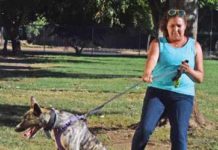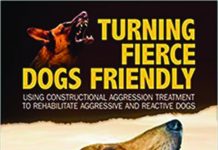Maybe it was after the time your mild-mannered Maltese puppy was dramatically barrel-rolled by the fun-loving Labrador during a critical developmental period. Or maybe the potentially personality-altering offense was more obvious – like a blatant attack by another dog while on a walk.
In either case, it’s very possible the experience has left your dog leery of other dogs. And with good reason! In many dogs, this well-founded fear presents as an aggressive front; after all, the best defense is a strong offense. While your dog might look like he’s trying to be a “tough guy,” what he’s really saying is, “HELP! I’m very frightened of that dog. Please don’t let it come any closer. Get back! Get away!”
This is problematic for many reasons. Owners are often embarrassed by their dog’s outbursts, not understanding that the unwanted behavior is rooted in an emotional issue (fear) and is not a display of disobedience. A recent Facebook post (author unknown) sums it up beautifully: “Your dog isn’t giving you a hard time; he’s having one!” Yes!
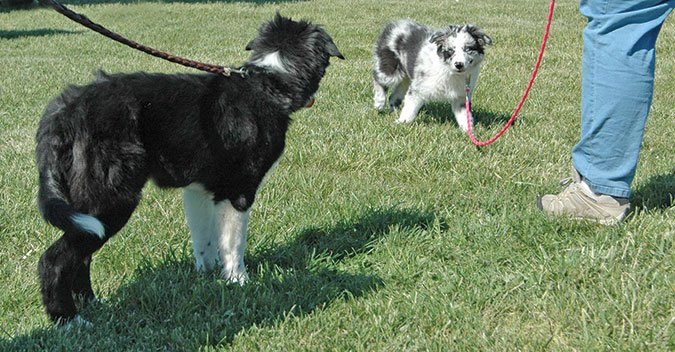
Dog Reactivity Comes from Distress
Beyond the human hang-ups and logistical challenges associated with a dog who now displays reactive behavior in the presence of other dogs, we must consider the impact on the dog. Reactive outbursts are the product of distress, and distress is serious business. It takes a long time for the body to recover from the jolt of hormones that happens during a distressful event. This altered brain state can leave your dog susceptible to triggers he might not otherwise react to, which is why many dogs can seem “edgy” for some time following a particularly stressful event.
According to Sara Reusche, CBCC-KA, CPDT-KSA, CVT, of Paws Abilities Dog Training in Rochester, Minnesota, while the initial adrenaline spike begins to subside after about 15 minutes, it can take between two to six days for glucocorticoids, like cortisol, to return to baseline levels, provided no other stressors occur. This is especially challenging for dogs who react to stimuli (other dogs, kids, skateboards, etc.) while on daily walks, as it’s unlikely their cortisol and related hormone levels ever have a chance to return to normal.
Reusche adds that dogs who live with chronic distress are more likely to experience chronic health issues such as allergies and gastrointestinal disturbances. Chronic distress can also hasten the aging process, decrease cognitive function, and weaken the immune system, delaying wound healing and making the dog more susceptible to disease and infections (such as urinary tract infections). Here are things you can do to get the stress monkey off your backs:
1. Give yourselves a break.
Like the joke goes, “I told my doctor it hurts when I bend my elbow. His solution? Don’t bend my elbow!” Avoidance is not without its merits.
When helping a dog recover from a reactivity issue, it’s important to keep your dog sub-threshold. This means going to great lengths to avoid putting the dog in situations where he feels so overwhelmed that he exhibits an emotional outburst. In densely populated areas, this often requires taking neighborhood walks during off-hours, or skipping the neighborhood altogether in favor of a shorter walk in a nearby shopping center. Both tactics serve to reduce unwanted dog encounters, especially when you aren’t prepared to train your way through the situation.
Similar tactics include ducking behind parked cars, heading up a driveway, crossing the street, or abruptly changing directions. These are all reasonable, supportive measures that can be taken in an effort to quickly increase distance between yourselves and another dog. Obviously, this is easier when the other dog is on leash. For tips on handling loose-dog encounters, see “Tips on Stopping a Loose Dog from Approaching You,” WDJ May 2016.
Distance is your friend! Staying “sub-threshold” is largely about understanding at what distance your dog can acknowledge another dog’s presence yet still feel safe enough to not react.
2. Don’t punish your dog!
Harsh reprimands, leash-pops, and other forms of punishment might appear to offer relief, but, in reality, punishment often suppresses behavior only temporarily.
Reactivity is an emotional issue. The dog growls, barks, and lunges because of how he feels. Punishing the behavior is an ill-fated attempt to address the issue by focusing on the symptoms, not the cause. It’s important to get to the root of the behavior – the dog’s fear of other dogs, which is what’s driving his behavior.
Punishment can also make problems worse when dogs, who are masters at making strong associations, pair the punishment with the trigger. For example, let’s say a dog growls when other dogs get too close. When he does, his owner issues a sharp collar correction and a harsh, “Quiet!” – both of which are unpleasant to the dog. Many dogs will begin to associate the sight of another dog with the impending act of aggression from the handler. In the dog’s mind, “See! Other dogs are bad; they even make my owner aggressive!” And then the dog works even harder to keep the “bad dogs” away!
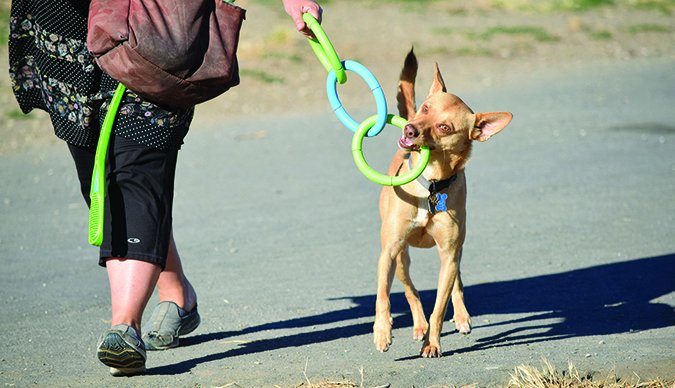
3. Change your dog’s emotional response to his trigger.
As you work to keep your dog sub-threshold to help manage his behavior, you can also aim to change how he feels about other dogs. Counter-conditioning is a powerful tool to help change a dog’s emotional state in the presence of a trigger. You can use two different types of counter-conditioning for a dog who has been traumatized: classical counter-conditioning and operant counter-conditioning.
Counter-conditioning is used in situations where the dog has already formed a negative association with something, because you’re trying to counter, or change, the association. This is most often accomplished with a powerful primary reinforcer, such as high-value treats, but access to favorite toys can also work for dogs who are highly motivated by toys.
In classical counter-conditioning, the goal is to try to transfer the positive feelings the dog has for high-value treats (or toy play) onto the trigger (in this case, the presence of other dogs), thus creating a new association in the dog’s mind. For example, when you know at what distance your dog can see other dogs, but still feel safe enough to not react, be prepared to feed a steady stream of treats the entire time the trigger (another dog) is within eyesight. As soon as the dog is out of sight, the treats stop.
Trainer Jean Donaldson, author of The Culture Clash, calls this “Open Bar, Closed Bar.” When the trigger is present, the bar is open and the treats flow freely. Once the trigger goes away, the bar is closed. People often mistakenly refer to this as using treats to “distract” the dog, but behavioral science is hard at work behind the scenes!
Also useful in mild cases of reactivity for building a new, improved response to the trigger, is operant counter-conditioning: when in the presence of the trigger, the dog is asked to perform a specific behavior that is incompatible with the unwanted behavior.
For example, a dog who might otherwise bark or lunge at other dogs is asked to “look,” “watch,” or “sit” instead. It works because, through training, the dog has learned to enjoy performing the alternative behaviors (and being rewarded for doing so), and those good feelings help create a new and happy association with the trigger.
Note: If this seems difficult for your dog, you’re not keeping him at a sub-threshold distance from his trigger.
4. Manage your own stress signals.
Owners, too, often become tense in the presence of the dog’s trigger, either because they’re also on hyper-alert following an attack, or because they worry their dog will react undesirably. They may tense their shoulders, hold their breath – and they almost always tighten the leash. These behaviors can all be huge red flags to our dogs – a clear sign that danger is imminent!
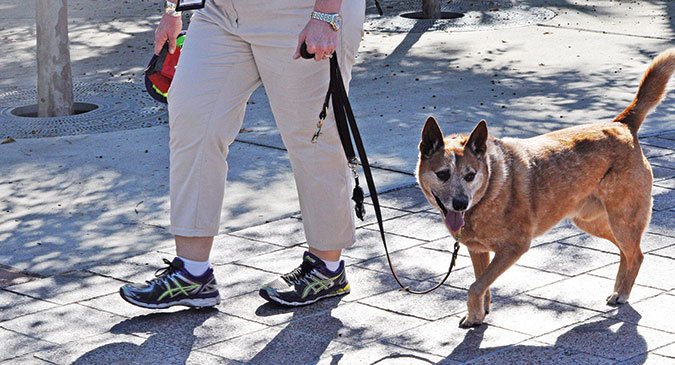
If you find yourself tensing up as triggers appear, consider the following:
Remember to breathe. When anxious, our breathing often becomes shallow. Deep, purposeful inhalations and exhalations help relieve tension (yours and your dog’s!)
Shake it off. Just as dogs use full-body shake-offs to relieve tension, humans also benefit. Practitioners of Tension & Trauma Release Exercise® believe a good shake helps release muscular tension, calms the nervous system, and encourages the body to return to a better state of balance.
Sing to your dog. My training mentor often asks clients to sing “Happy Birthday” to their dogs when she sees them visibly tensing up. It sounds silly, and people feel silly doing it, but that’s why it works. It’s much harder to remain physically tense when you’re laughing about singing to your dog. Plus, most of us have strong positive associations with the song. (Operant counter-conditioning for the win!)
Relax the leash. Your emotions travel down a tight leash like the Autobahn! Plus, a tight leash restricts natural dog body language and can make your dog feel trapped, increasing the odds he’ll react defensively.
5. Create “safe” encounters with other dogs.
Dog encounters out in public are unpredictable, which means it can sometimes be hard to keep dogs sub-threshold while on the road to recovery.
While it’s important to try to do the best you can during everyday outings with your dogs, it’s also useful to recruit dog-owning friends to help. Dogs with mild reactivity often benefit from casual dog walks with mellow dogs who are indifferent to other dogs. Consider, also, attending a well-run good-manners class where a dog in emotional rehab can remain sub-threshold while building trust in his owner’s ability to keep everyone safe around other dogs.
Stephanie Colman is a writer and dog trainer in Southern California.




